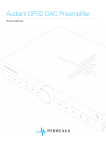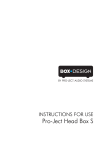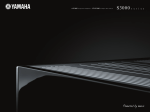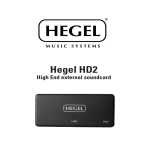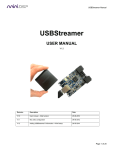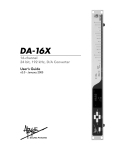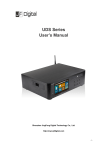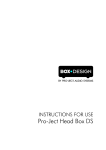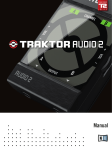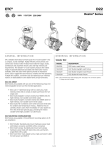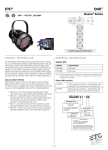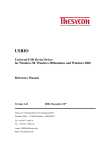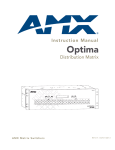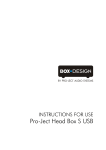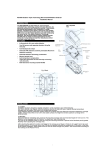Download ClickBook Printer
Transcript
1 Anedio D2 DAC Welcome Thank you for choosing the Anedio D2 DAC! D2 DAC (Digital-to-Analog Converter) with Volume Control Operating Manual Anedio is founded upon the principle that the enjoyment of highestquality music should be available for everyone, not just for the esoteric few. Our quest is to attain the most realistic and faithful reproduction of music, enabling the listener to experience its beauty, pathos, joy, and delight more fully. At the same time, we strive to make our products affordable by focusing on the essentials and using the most cost-effective technologies. The result, we believe, is a unique combination of sonic excellence and superb value. We hope you will experience many years of joy and pleasure in listening to music. Important Safety Instructions The lightening symbol within an equilateral triangle is intended to alert the user to the presence of un-insulated dangerous voltage within the product’s enclosure that may constitute a risk of electric shock. The exclamation mark within an equilateral triangle is intended to alert the user to important operating and maintenance instructions. 1. Read these instructions. 2. Keep these instructions. 3. Heed all warnings. 4. Follow all instructions. 5. Do not use this apparatus near water. 6. Clean only with dry cloth. 7. Do not block any ventilation openings. Install in accordance with the manufacturer’s instructions. 8. Do not install near any heat sources such as radiators, heat registers, stoves, or other apparatus (including amplifiers) that produce heat. 9. Do not defeat the safety purpose of the polarized or groundingtype plug. A polarized plug has two blades with one wider than the other. A grounding type plug has two blades and a third Anedio D2 DAC grounding prong. The wide blade or the third prong are provided for your safety. If the provided plug does not fit into your outlet, consult an electrician for replacement of the obsolete outlet. 2 3 Anedio D2 DAC Setting Up Package Contents 10. Protect the power cord from being walked on or pinched particularly at plugs, convenience receptacles, and the point where they exit from the apparatus. • D2 DAC • IR Remote Control • Windows USB Driver Installation CD 11. Only use attachments/accessories specified by the manufacturer. • AC Power Cord • Extra Fuse and Jumpers • User Manual 12. Use only with the cart, stand, tripod, bracket, or table specified by the manufacturer, or sold with the apparatus. When a cart is used, use caution when moving the cart/apparatus combination to avoid injury from tip-over. Front Panel 13. Unplug this apparatus during lightning storms or when unused for long periods of time. 14. Refer all servicing to qualified service personnel. Servicing is required when the apparatus has been damaged in any way, such as power-supply cord or plug is damaged, liquid has been spilled or objects have fallen into the apparatus, the apparatus has been exposed to rain or moisture, does not operate normally, or has been dropped. WARNING: To reduce the risk of fire or electric shock, do not expose this apparatus to rain or moisture. The apparatus shall not be exposed to dripping or splashing, and no objects filled with liquids, such as vases, shall be placed on the apparatus. To completely disconnect this equipment from the ac mains, disconnect the power supply cord plug from the ac receptacle. The mains plug of the power supply cord shall remain readily operable. Rear Panel Anedio D2 DAC 4 USB Driver Installation (Windows Only) Before connecting the D2 to your computer, please install the Windows driver first. On Mac OS X, there is no need for driver installation since the USB 2.0 audio is supported natively. (1) Insert the Anedio USB Driver CD into your PC. If the installer does not launch automatically, then click ausbaudio_v1.22.0.exe in the CD directory. Some USB devices might interfere with the installation of the D2, and it is better to disconnect all other USB devices attached to your computer. (2) Follow the onscreen directions. Please allow 1 – 2 minutes for the installer to complete. On older computers, it may take longer. (3) When instructed to plug in the device, simply connect the D2 to the PC using a USB cable. When plugging the USB cable into the USB input, be sure to apply sufficient force so that the plug is inserted promptly without hesitation. Setting up Media Players for Bit-transparent Playback The D2’s USB interface is bit-transparent, passing on the audio data without any alteration. However, to ensure bit transparency all the way from music files to the DAC, you still need to set up the media player software properly. Please see our website (under “Technology”) for detailed examples on how to setup media players for your operating system (Windows 7/Vista, XP, or Mac OS X). 5 Anedio D2 DAC Placement of the D2 DAC If you are using the D2 DAC primarily to listen to music through loudspeakers (instead of headphones), place the DAC and the amplifier between the two loudspeakers, instead of setting it off to one side. This keeps the lengths of interconnects and speaker cables short for optimal sonic performance. Remember that the ideal cable is no cable. The signal can never be improved by going through a longer cable. As you shorten the cable length, the signal fidelity approaches that of the ideal cable. The best practice, therefore, is to keep the cables as short as possible by placing the DAC and the amplifier between the loudspeakers. Bypassing the Preamp If all your music sources are digital, you do not need a preamp. The built-in volume control allows power amplifiers to be connected directly to the D2 DAC. Bypassing the preamp is one of the most significant steps toward a higher level of transparency. To ensure highest signal-to-noise ratios at realistic listening levels, our design uses an optimal combination of 32-bit digital attenuators and thinfilm resistor dividers. Connecting Interconnects and Cables Before connecting, turn off the power to all the components in your system. Digital Inputs: The D2 DAC accepts four digital inputs, all of which are galvanically isolated for excellent immunity to ground loop noise. Channel 1 — USB (24 bits, 44.1K, 48K, 88.2K, 96K, 176.4K, 192KHz) Channel 2 — SPDIF, 75-ohm BNC (24 bits, 44.1K, 48K, 88.2K, 96K, 176.4K, 192KHz) Channel 3 — SPDIF, 75-ohm RCA (24 bits, 44.1K, 48K, 88.2K, 96K, 176.4K, 192KHz) Channel 4 — Toslink, Optical (24 bits, 44.1K, 48K, 88.2K, 96KHz) Anedio D2 DAC 6 Line Output: Connect the left and right channels to a power amplifier using a pair of RCA interconnects. Extravagant interconnects with exotic materials are unnecessary. Two characteristics, however, are important: (a) low shield (outer conductor) resistance; (b) robust mechanical design for reliable electrical contact. The shorter the cable, the more transparent your system will be. Connecting Power Cord For the lowest ground noise and hum, it is highly recommended that the power cords of all components be connected to a single point — usually a single surge protector with multiple outlets. This keeps all components referenced to a single point, as far as it is practically possible, thus minimizing the differences in ground potentials among the components. Never use a 3-prong-to-2-prong adapter to fix a ground loop problem. This will disable the safety earth ground and may cause electric shocks. Surge Protectors A surge protector is strongly recommended so that the components are protected from large power lines spikes, which can occur, for instance, from lightning strikes. Power Switch The power switch is located in the back panel. Toggle the switch to the “1” position to turn power on. To turn power off, toggle the switch to the “0” position. When turning on and off your music system with a power amplifier, the power amplifier should be the last component to be turned on and the first component to be turned off. This prevents power on/off transients from being transmitted to loudspeakers. 7 Anedio D2 DAC Isolating Cable TV Ground If you have a cable TV connected to your audio system, ensure that the cable ground is galvanically isolated from the audio ground. The cable TV ground, tied to the earth outside your home, is at a significantly different potential and can cause audible hum if it is not isolated properly. If you suspect this is the case, insert a cable TV ground isolator inside your home, just before your cable set-top box or TV RF input. Lock/Unlock Indicator LEDs The green LED light just above the volume display indicates that the DAC is properly locked to the incoming data. The red LED indicates that the DAC is unlocked due to the absence of valid data. Anedio D2 DAC 8 Using the D2 DAC Remote Control The D2 DAC works with the Sony RM-EZ4 Universal Remote, which was chosen for its ergonomic design. Its large buttons, easily visible and intelligently placed, make it particularly suitable for controlling the volume level. 9 Anedio D2 DAC decrease the volume level. The numeric keys on the remote control can also be used to set the volume level. Simply key in the volume level, followed by the “ENT” key. Only those remote keys described in the manual are functional. For use with the D2 DAC, select the “CBL/SAT” mode. The volume level changes in steps of 0.5 dB. The maximum level, 0 dB, is displayed as “99”. For example, “59” on the display means that the volume level is -20 dB from the maximum. Channel Selection The channel can be set either by pressing the channel button on the front panel or by pressing the channel +/- button on the remote control. Safe Volume Level At power on, the volume level is limited to a safe level (“81” on the display) in order to prevent accidental damages to loudspeakers or headphones. To prevent entering high volume levels accidentally, the level above “81” cannot be entered directly from the numeric keys, but only by turning the volume knob or by pressing the volume + key. When selected, the channel number is displayed momentarily (e.g., “C2” for Channel 2). Volume Control The volume level can be set either by turning the volume knob or by pressing the volume +/- button on the remote control. As you change the volume from “81” to “82”, you will hear a relay click. The D2 DAC uses an optimal combination of 32-bit digital attenuators and relay-controlled thin-film resistor dividers in order to ensure highest signal-to-noise ratios at realistic listening levels, Mute (Remote Control Only) The sound can be muted by pressing the “MUTING” button on the remote control. Pressing the “MUTING” button again restores the previous volume level. Using Another Universal Remote Control Holding down the volume +/- button will continually increase or As with most people, we do not like to pile up remote controls in our living rooms. In case you want to use another universal remote to control the D2 DAC, we’ve made it easy to do so by using a common IR protocol that is readily recognized by most universal remote controls. Simply follow the learning instruction for the universal remote of your choice, and you will be ready to control the D2 DAC within minutes. Anedio D2 DAC 10 Headphone Gain Setting The default gain setting of the headphone amplifier (4 Vrms output) is more than adequate in almost all situations. For those desiring a slightly higher power, the headphone amp gain can be increased with internal jumpers. 11 Anedio D2 DAC Specifications D/A Converter IC: ESS Technology ES9018 Sabre Reference 32-bit DAC Sample Rates: 44.1K-192KHz Total Harmonic Distortion + Noise: 0.0003% @ 1KHz, 0dBFS 0.0003% @ 20KHz, 0dBFS Intermodulation Distortion: 0.00015% @ 19KHz + 20KHz 0 dBFS 2nd order IMD Signal-to-Noise Ratio: 123 dB, 20-20KHz BW, 2 Vrms (unbalanced) 125 dB, A-weighted, 2 Vrms (unbalanced) 126 dB, 20-20KHz BW, 4 Vrms (balanced) 128 dB, A-weighted, 4 Vrms (balanced) DAC Master Clock Jitter: 0.5 ps rms (3) Remove only the 8 flat-head screws from the side of the DAC (4 on each side) using a 1/16” hex driver. Total Jitter at DAC Output: Refer to “Measuring Jitter” on Anedio web site (4) Remove the top cover by pulling it up vertically. Avoid pulling it toward the back as it will interfere with the PCB. Frequency Response: 20 Hz - 20 KHz (-0.15dB) Phase: Non-inverting Channel Separation: 140 dB @ 1KHz 135 dB @ 20KHz Digital Inputs: USB, SPDIF 75-ohm BNC, SPDIF 75-ohm RCA, Toslink optical Digital Input Resolution and Sample Rate: USB: 24 bits, 44.1K, 48K, 88.2K, 96K, 176.4K, 192KHz SPDIF 75-ohm BNC: 24 bits, 44.1K, 48K, 88.2K, 96K, 176.4K, 192KHz SPDIF 75-ohm RCA: 24 bits, 44.1K, 48K, 88.2K, 96K, 176.4K, 192KHz Tosllink Optical: 24 bits, 44.1K, 48K, 88.2K, 96KHz Digital Volume Control Steps: 0.5 dB Volume Matching between Channels: Better than 0.1 dB Line Outputs: Unbalanced: RCA jacks with gold-plated contacts and Teflon dielectric Balanced: Shielded Neutrik XLR connectors Line Output Level: 2.0 Vrms (unbalanced) 4.0 Vrms (balanced) Line Output Impedance: 75 ohms (unbalanced) 80 ohms (balanced) Line Output Offset: 3 mV max Before opening the cover, be sure to unplug the AC power cord from the D2 DAC. Failure to do so can result in electric shock. (1) Unplug the AC power cord from the D2 DAC. (2) Wear an antistatic wrist strap and affix its alligator clip to grounded bare metal, such as the metal chassis of a desktop computer that is connected to AC mains. Failure to do so can damage the components inside the D2. (5) Locate the two 2x2 headers near the front of the D2. Insert the four jumpers, making sure that the jumpers are inserted in the correct orientation as shown in the photo. Anedio D2 DAC 12 13 Anedio D2 DAC Headphone Amp Maximum Output Voltage: 4.0 Vrms (default) 5.3 Vrms (high-gain, set with internal jumpers) Headphone Amp Maximum Output Power (default setting): 530 mW into 30 ohms 260 mW into 62 ohms 53 mW into 300 ohms Headphone Amp Maximum Output Power (high-gain, set with internal jumpers): 830 mW into 30 ohms 460 mW into 62 ohms 95 mW into 300 ohms Headphone Amp Current Output: 250 mA peak Headphone Amp THD+N: 0.0004%, 4Vrms into 30ohms Headphone Amp Intermodulation Distortion: 0.0002% @ 19KHz + 20KHz, 4Vrms into 30ohms Headphone Amp Output Impedance: 0.035 ohm, 20-20KHz • Ensure that the interconnects and cables are plugged in fully and seated properly. Headphone Jack: 1/4" TRS, gold-plated USB Streaming Mode: Asynchronous • If the above steps do not solve the problem, recycle power by turning off the D2 DAC, waiting 10 seconds, and turning it back on. USB Clocks: Two Independent Low-Jitter Master Clocks USB Processor: XMOS 500 MHz real-time processor USB Audio Operating System Requirement: Windows 7, Vista, XP Apple Mac OS X USB Audio Driver: Thesycon driver for Windows No driver installation for Apple OS X Galvanic Isolation: All digital inputs, using ultra high-speed transformers Power Consumption: 7W Dimensions (W x H x D): 9.0 x 2.8 x 10.7 inches (230 x 71 x 272 mm) Weight: 4.6 lbs (2.1 Kg) Trouble Shooting Symptoms No power Remedy • Ensure the power cord is plugged in fully. • Check the fuse. If blown, ensure that the outputs are not shorted. Replace it only with 0.2A/250V 5x20mm Time-lag (slow-blo). Using an incorrect fuse will void the warranty. Power on but no sound • Ensure that the correct channel is selected. • Ensure that the source component is turned on. • Ensure that the D2 DAC is not muted, indicated by “0” on the volume display. • Ensure that the power amplifier is turned on. No sound through USB (Ch 1) • In your media player, ensure that “Anedio USB Audio” is selected as the device for playback. • If the above steps do not solve the problem, unplug the USB cable, wait 10 seconds, and plug it back. • When plugging the USB cable into the D2 converter, be sure to apply sufficient force so that the plug is inserted promptly without hesitation. Hum • Ensure that all components are connected to a single power strip. • If there is a cable TV or antenna connection, ensure that the cable/antenna grounds are galvanically isolated from the audio ground. This may require inserting a ground isolator. CE Compliance This equipment has been found to comply with the requirements of the EN 55022 and EN 61000-6 standards. • Ensure that the USB cable is plugged in fully and seated properly. Diffused stereo imaging • Ensure that the loudspeaker phase is not inverted. If the problem persists, please contact Anedio via the Contact page at www.anedio.com. Anedio D2 DAC 14 Warranty & Repair One-Year Limited Warranty Anedio warrants this product to be free from defects in materials and workmanship, subject to the terms set forth below, for periods up to one year from the date of original purchase. The warranty includes parts and labor. Anedio will remedy the problem by repair or replacement, as we deem necessary, to restore the product to full performance. Anedio will pay the shipping cost one way (the return portion). This warranty does not cover cosmetic damage or damage due to accident, misuse, abuse, negligence while in the possession of the customer. Tampering by persons other than factory-authorized service personnel or failure to fully comply with the operating instructions specified in the manual will void the warranty. Any unauthorized component replacement or modifications performed to the product will void the warranty. The warranty is transferable from the original owner to a subsequent owner as long as a copy of the bill-of-sale from Anedio accompanies the re-sale. Repair In the event of a defect or malfunction, contact Anedio for return authorization (via the Contact page at www.anedio.com). Unauthorized returns will not be accepted. Products must be returned using original packaging material only. Anedio is not responsible for damages incurred during transit if the original factory packaging is not used. The packaging material may be purchased from Anedio if necessary. WARNING: Repairs are to be performed by qualified service personnel only. To reduce the risk of electric shock, do not perform any servicing other than that contained in the operating instructions. www.anedio.com Revision 1.0, 2012










